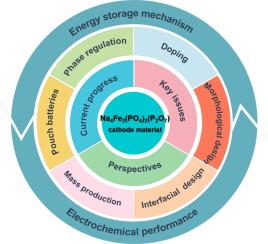Current progress of Na4Fe3(PO4)2(P2O7): Key issues, modifications, and perspectives
IF 14.9
1区 化学
Q1 Energy
引用次数: 0
Abstract
The sodium-ion battery (SIB) cathode material, Na4Fe3(PO4)2(P2O7) (NFPP), has become a focal material in both academia and industry due to its low cost, long lifespan, and high safety. In the recent three years, substantial efforts have been devoted to promoting the practical applications of NFPP by optimizing its electrochemical performance and disclosing the reaction mechanisms. Various modification strategies and their effect mechanisms have been explored, and the performance evaluation of NFPP has progressively advanced from laboratory-scale coin cells to practical pouch cell configurations. Nevertheless, there remains a lack of systematic reviews comprehensively assessing the developmental status and application readiness of NFPP. This review critically examines NFPP’s fundamental structural characteristics and proposes four key development issues. Then, the latest research advances are introduced with explicit differentiation of design strategies and their mechanistic impacts. Notably, we provide a dedicated discussion on NFPP’s current pouch cell performance metrics, while highlighting two critical yet underexplored research directions (enhancing air stability and improving tap density) for commercial viability.

Na4Fe3(PO4)2(P2O7)的研究进展:关键问题、改进及展望
钠离子电池(SIB)正极材料Na4Fe3(PO4)2(P2O7) (NFPP)因其低成本、长寿命和高安全性而成为学术界和工业界关注的焦点材料。近三年来,人们通过优化NFPP的电化学性能和揭示其反应机理,为推动NFPP的实际应用做出了大量努力。人们探索了各种改性策略及其作用机制,NFPP的性能评估也从实验室规模的硬币电池逐步发展到实际的袋状电池配置。然而,仍然缺乏系统的综述,全面评估NFPP的发展状况和应用准备情况。本文批判性地考察了NFPP的基本结构特征,并提出了四个关键的发展问题。然后,介绍了最新的研究进展,并明确了设计策略的区别及其机制影响。值得注意的是,我们对NFPP目前的袋状电池性能指标进行了专门的讨论,同时强调了两个关键但尚未充分开发的研究方向(提高空气稳定性和提高水龙头密度),以实现商业可行性。
本文章由计算机程序翻译,如有差异,请以英文原文为准。
求助全文
约1分钟内获得全文
求助全文
来源期刊

Journal of Energy Chemistry
CHEMISTRY, APPLIED-CHEMISTRY, PHYSICAL
CiteScore
19.10
自引率
8.40%
发文量
3631
审稿时长
15 days
期刊介绍:
The Journal of Energy Chemistry, the official publication of Science Press and the Dalian Institute of Chemical Physics, Chinese Academy of Sciences, serves as a platform for reporting creative research and innovative applications in energy chemistry. It mainly reports on creative researches and innovative applications of chemical conversions of fossil energy, carbon dioxide, electrochemical energy and hydrogen energy, as well as the conversions of biomass and solar energy related with chemical issues to promote academic exchanges in the field of energy chemistry and to accelerate the exploration, research and development of energy science and technologies.
This journal focuses on original research papers covering various topics within energy chemistry worldwide, including:
Optimized utilization of fossil energy
Hydrogen energy
Conversion and storage of electrochemical energy
Capture, storage, and chemical conversion of carbon dioxide
Materials and nanotechnologies for energy conversion and storage
Chemistry in biomass conversion
Chemistry in the utilization of solar energy
 求助内容:
求助内容: 应助结果提醒方式:
应助结果提醒方式:


